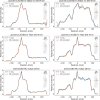Flexible and modular PET: Evaluating the potential of TOF-DOI panel detectors
- PMID: 40089973
- PMCID: PMC12059530
- DOI: 10.1002/mp.17741
Flexible and modular PET: Evaluating the potential of TOF-DOI panel detectors
Abstract
Background: Panel detectors have the potential to provide a flexible, modular approach to Positron Emission Tomography (PET), enabling customization to meet patient-specific needs and scan objectives. The panel design allows detectors to be positioned close to the patient, aiming to enhance sensitivity and spatial resolution through improved geometric coverage and reduced noncollinearity blurring. Parallax error can be mitigated using depth of interaction (DOI) information.
Purpose: One of the key questions the article addresses is: Do panel detectors offer viable clinical imaging capabilities, or does limited angular sampling restrict their utility by causing image distortions and artifacts? Additionally, this article explores the scalability of panel detectors for constructing scanners with a long axial field of view (LAFOV).
Methods: Monte Carlo simulations using GATE software were used to assess the performance of panel detectors with various DOI resolutions and Time-of-Flight (TOF) resolutions as fine as 70 ps. The 30 30 cm panels comprised pixelated 3 3 20 mm LSO crystals. Simulations were run on large high-performance computing clusters (122,000 CPU cores). Open-source CASToR software was used for (TOF MLEM) image reconstruction. The image quality of the scanners was assessed using a range of phantoms (NEMA, Derenzo, XCAT, and a high-resolution brain phantom). The Siemens Biograph Vision PET/CT scanner served as the reference model. The performance of larger 120 60 cm panels was also evaluated.
Results: Sensitivity increases over threefold when panel-panel distance is reduced from 80 to 40 cm. The noise equivalent count rate, unmodified by TOF gain, of the panel detectors matches that of the reference clinical scanner at a distance of approximately 50 cm between the panels. Spatial resolution perpendicular to the panels improves from 8.7 to 1.6 mm when the panel-panel distance is reduced, and 70 ps + DOI detectors are used instead of 200 ps, no-DOI detectors. With enhanced TOF and DOI capabilities, panel detectors achieve image quality that matches or surpasses the reference scanner while using about four times less detector material. These detectors can be extended for LAFOV imaging without distortions or artifacts. Additionally, improving TOF and DOI performance enhances contrast-to-noise ratios, thereby improving lesion detection.
Conclusions: A compact 2-panel PET scanner can match the performance of conventional scanners, producing high-quality, distortion-free images. Its mobility and flexibility enable novel applications, including bedside imaging and intensive care unitdiagnostics, as well as imaging in positions such as sitting or standing. Furthermore, the modularity of panel detectors offers the potential to construct cost-effective, high-performance total-body imaging systems.
Keywords: GATE Monte Carlo simulations; depth of interaction (DOI); limited angle pet; panel detectors; time‐of‐flight (TOF).
© 2025 The Author(s). Medical Physics published by Wiley Periodicals LLC on behalf of American Association of Physicists in Medicine.
Conflict of interest statement
The authors declare no conflicts of interest.
Figures














References
-
- Sajedi S, Bläckberg L, Majewski S, Sabet H. Limited‐angle TOF‐PET for intraoperative surgical applications: proof of concept and first experimental data. JINST. 2022;17(01):T01002. doi: 10.1088/1748-0221/17/01/T01002 - DOI
-
- Gao M, Chen HH, Chen FH, et al. First results from all‐digital PET dual heads for in‐beam beam‐on proton therapy monitoring. IEEE Trans Radiat Plasma Med Sci. 2021;5(6):775‐782. doi: 10.1109/TRPMS.2020.3041857 - DOI
Publication types
MeSH terms
Grants and funding
LinkOut - more resources
Full Text Sources

